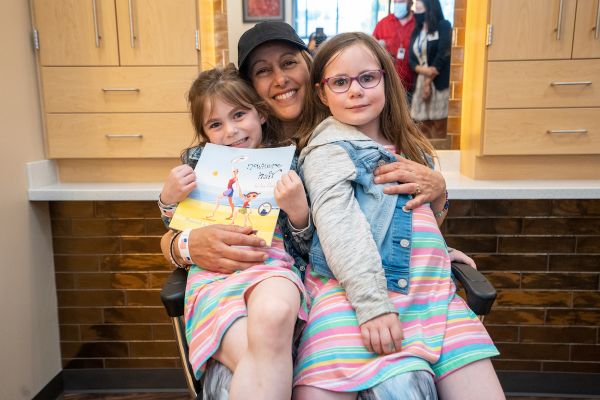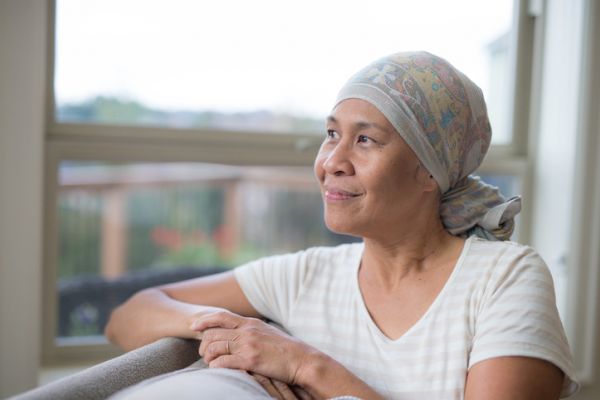This is the second Cancer Talk article in a two-part series about hair loss and chemotherapy. The first focused on “Chemotherapy and Hair Loss — Planning Ahead.”
When you’re growing up, most of your cells are constantly multiplying, usually through a process in which one cell divides into two cells. (This is called cell multiplication.) In general, when you become an adult, this occurs only when your body needs to repair itself.
However, some normal cells continue to multiply quickly. They include cells that must constantly grow or renew themselves, such as bone marrow (where blood cells are made), skin, the lining of the digestive tract (mouth, esophagus, stomach and intestines) — and hair follicles. Because some types of chemotherapy attack not only cancer cells but all cells that multiply quickly, those drugs are more likely to cause hair loss. (See chart below.)
New Era Cap Foundation Elevate Salon at Roswell Park
“We provide a respite for patients where they can feel comfortable and understood in an uplifting environment.” Visit us on the first floor of the Clinical Sciences Center, next to the Breast Oncology Center.
If you are receiving a chemotherapy that is likely to damage hair follicles (the root of the hair), hair loss usually begins about two weeks after treatment begins. Hair loss can range from thinning of the hair on your head to loss of all body hair. (Hair growth usually returns once chemotherapy has ended.) Chemotherapy-induced hair loss may be reduced by stopping or slowing the absorption of these drugs into the hair follicles.
Scalp cooling and cold caps
Scalp cooling, or scalp hypothermia, has shown some success in reducing/preventing hair loss on the head. The idea is to lower the temperature of the scalp during — and right before and after — chemotherapy. The cold temperature causes the blood vessels in the scalp to narrow. If less blood gets to the cell, then less of the chemotherapy drug is circulated through the hair bulb and follicle, and the hair is more likely to remain in place.
In the U.S., two systems are available – a cap that has coolant circulating through it, and a frozen cap that must be replaced with another frozen cap about every 30 minutes. These products are approved for people who have a solid tumor — such as breast, ovarian or prostate cancer — and who are receiving chemotherapy drugs that are likely to cause hair loss. The caps are not currently approved for use in people who have blood or lymph cancers.
Roswell Park patients have access to the Paxman scalp cooling system. The system is approved for people who have a solid tumor — such as breast and ovarian — and who are receiving chemotherapy drugs that are likely to cause hair loss.
Concerns
- Side effects include headache and feeling cold.
- Some patients cannot tolerate the cold temperatures on their head and discontinue use of the product.
- It can be expensive and is not yet covered by many health insurers in the U.S.
Want to know more?
- "Effect of a Scalp Cooling Device on Alopecia in Women Undergoing Chemotherapy for Breast Cancer: The SCALP Randomized Clinical Trial." Journal of the American Medical Association (JAMA) 2017 Feb 14;317(6)
- Financial Assistance: HairToStay is a nonprofit organization in the U.S. that offers some financial assistance to qualified patients. They also offer information and support about scalp cooling.
Chemotherapy drugs that commonly cause hair loss or thinning
Generic name/brand name
- altretamin/Hexalen®
- carboplatin/Paraplatin®
- cisplatin/Platinol®
- cyclophosphamide/Cytoxan®, Neosar®
- daunorubicin/Cerubine®
- docetaxel/Taxotere®
- doxorubicin/Adriamycin®, Doxil®
- epirubicin/Ellence®
- eribulin/Halaven®
- etoposide IV/VePesid®
- idarubicin/Idamycin®
- ifosfamide/Ifex®
- irinotecan/Camptosar®
- ixabepilone /Ixempra®
- paclitaxel/Taxol®
- topotecan/Hycamtin®
- vincristine/Marqibo®, Vincasar®
- vinorelbine/Navelbine®
This is not a complete list. Please talk with your doctor or clinical pharmacist to find out if your chemotherapy may cause hair loss. Individual responses vary. Drug dose, frequency of treatment and other factors may contribute to the amount or type of hair loss.



